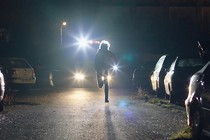The Fifth Gospel of Kaspar Hauser: the eyes of bewilderment
- The experimental piece of Alberto Gracia hits the Seville Film Festival after coming out of Rotterdam with the FIPRESCI prize

Something is wrong with these years of estrangement, lack of connection and bewilderment – even though most want to think otherwise – to make Kaspar Hauser's life, turned almost into a legend, come back to cinema not once but twice. Last year it was Italian filmmaker Davide Manuli's The Legend of Kaspar Hauser [+see also:
trailer
film profile], starring Vincent Gallo, and now, it's time for Spanish artist and filmmaker Alberto Gracia's The Fifth Gospel of Kaspar Hauser (photo). The film, entirely produced by Spanish company Zeitun Films, was premiered at the International Film Festival Rotterdam, where it was awarded the FIPRESCI prize, and now hits the Seville European Film Festival.
To revisit the story of Kaspar Hauser - the young man who showed up in Nuremberg after being raised in complete isolation and surrounded by a deep mystery that was never solved even after his enigmatic death - means, in broad strokes, to look at the conflict between man and mankind. Werner Herzog has already shown how a man estranged from mankind can discover how bizarre it is, in his magnificent The enigma of Kaspar Hauser. Now, 39 years later, Gracia thinks about that estrangement, through images that try to sneak into reasoning, having to overcome endless obstacles in order to do it.
The Fifth Gospel of Kaspar Hauser wants to show what untrained eyes see, through a noticeable experimental vision, deprived of any conventional narration, and displayed as a series of eerie and puzzling episodes. Gracia crafts an absolutely visual piece by also connecting to key elements in Hauser's story -the wooden horse, captivity, solitude-. Sometimes direct -the naked character in the burnt woods-, sometimes sarcastic -the cinematographic meeting of the different characters Hauser is made of (Batman, the sailor or the girl)- and sometimes dreamy -their visit to the top of the mountains-, the movie reflects on itself, the wild human, his eyes, and if it were not enough, on cinema.
(Translated from Spanish)
Did you enjoy reading this article? Please subscribe to our newsletter to receive more stories like this directly in your inbox.






















